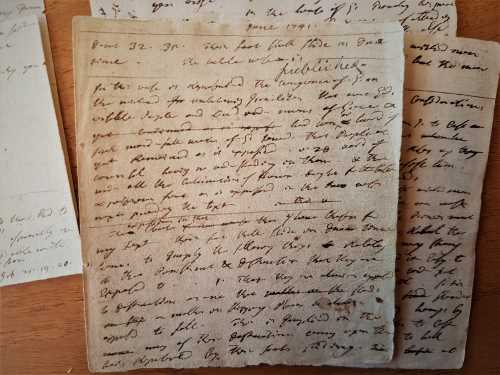The research project The Language of Eighteenth-Century American Colonial Sermons. A Rhetorical and Stylometric Analysis is funded by the Polish Science Center (OPUS 2014/13/B/HS2/00905). The project is being carried out in the Institute of English Studies at the Jagiellonian University during the period of 2015-2018.
Research objective
The project aims to analyse approximately 300 sermons, in particular the revival sermons of the Great Awakening period (1739-1744), with the use of a new, interdisciplinary methodological approach to characterize their stylistic and communicative specificities. Particular emphasis is placed in the study on the analysis of rhetorical mechanisms, figures and intertexuality markers of sermons with respect to particular preachers. The methodology used in the project consists of the combination of the rhetorical model of analysis with the state of the art investigative tools of stylometry, a quantitative model of study. The project seeks to prove that the rhetorical features of revival sermons are inextricably linked with their rhetorical genre as well as the context in which they were written and delivered (in this case, the revivalist context of the Great Awakening period), in other words, that the existence of the colonial school of the “rhetoric of the revival” can be objectively quantified and verified. By analysing a large corpus of sermons, assembled and processed for the purpose of this project, the researchers seek to delineate the said features with respect to particular preachers: Jonathan Edwards, George Whitefield, Jonathan Parsons, Samuel Blair and Gilbert Tennent.
Thus, the consecutive objectives of the project include:
- determining the most important recurring rhetorical characteristics of the 18th century revivalist sermons from the quantitative standpoint
- determining the rhetorical mechanisms and language idiosyncrasies for particular preachers of the Great Awakening;
- enriching the methodological insight of the stylometric and rhetorical studies;
- valorising selected insights into the Great Awakening preaching tradition (especially the links between the styles of particular preachers) which may be confirmed or refuted with the aid of quantitative investigation.
The Results of the Study
A stylometric study of the corpus of sermons allowed to study the manner in which the image of God changes in the writings of Jonathan Edwards (1703-1758), one of the most influential 18th century American theologians and preachers. Contrary to what one could expect of a Puritan preacher, the representation of God in Edwards’s text is predominantly positive. The image is also highly dynamic, physical and associated with a number of verbs connotative of an experiential relationship with the natural world.

Preaching notes used by Jonathan Edwards for the delivery of Sinners in the Hands of an Angry God in 1740. Photo taken by dr Michał Choiński during his research stay at Yale University in October 2017.
“We aim here to verify the common misconception (common at least among the less theologically-oriented readers of Edwards in Europe) that the image of the Almighty found in the oeuvre of the Northampton divine is permeated with anger and resentment towards sinners, as well as to demonstrate the results which the digital humanities approach may yield for Edwards studies. With the help of the quantitative methods applied, we have been able to base our observations on statistics, instead of individual hermeneutic experiences which are unavoidably subjective. The research proves that the image of God in Edwards' writings is both multifaceted and mutable. The complexity resides in the Almighty being simultaneously portrayed as an object of religious reverence and a dynamic sustainer of the visible world. Statistically, "an angry God" from Sinners or Future Punishment is but an addition to an otherwise deeply devotional and benevolent depiction. Also, central as Edwards's image of God remains for most texts within the oeuvre, one can hardly claim it to be perdurable. Looking at the rich corpus of the studied texts from a wider comparative perspective and with the help of stylometry, we have been able to discern a stable evolution of the manner in which Edwards talks about God, a movement from the early sermons, towards the style of the treatises and philosophical writings. This quantitative conclusion could be used to inspire a fresh qualitative study of Edwards's texts, looking into the evolution of the image of God on a micro-scale and explaining the insight offered on a macroscale.”
From: Choiński M., Rybicki J., “Is God Really Angry at Sinners? A Stylometric Study of Jonahan Edwards’s Representations of God”, The Global Edwards, 2017, ed. Rhys Bezzant, Eugene, OR: Wipf & Stock, pp. 349-359)
As part of the grant research, the relationships between a number of preachers were also placed under scrutiny.
The three-dimensional network diagram above shows the scale of similarities and differences between ]individual texts by two preachers, Jonathan Edwards and George Whitefield (1714-1770), based on the frequencies of the most often occurring words. Noteworthy is the closeness of one of Whitefield's texts, a sermon “The Care of the Soul urged as the One Thing Needful.” he delivered on Kennington Common on May 20th 1739 to those authored by Edwards. Normally, such affinity could be indicative of authorial collaboration (or, at least, the use of similar rhetorical mechanisms).
The results of the research conducted in the project were presented at a number of conferences:
- Jonathan Edwards Congress (Melbourne, Australia, 24-28 August 2015),
- IBAAS (UK, Belfast, 7-9 April 2016),
- Digital Humanities Conference (Kraków, Poland, 11-16 July 2016),
- Digital Humanities Conference (Montreal, Canada, 8-11 August 2017),
as well as at number of guest talks delivered at:
- The University of Padua (Italy),
- Yale University (USA),
- Salem State University (USA),
- University of South Carolina (USA),
- Lomonosov State University (Russia),
- Polish Academy of Sciences
- Polish Academy of Learning.
Research team
- Dr Jan Rybicki (Principal Researcher): jkrybicki@gmail.com
- Dr Michał Choiński: michal.choinski@uj.edu.pl

